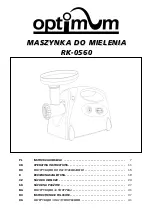
14
| English
2 609 000 229 | (19.1.09)
Bosch Power Tools
4) Power tool use and care
a) Do not force the power tool. Use the cor-
rect power tool for your application.
The
correct power tool will do the job better
and safer at the rate for which it was de-
signed.
b) Do not use the power tool if the switch
does not turn it on and off.
Any power tool
that cannot be controlled with the switch
is dangerous and must be repaired.
c) Disconnect the plug from the power
source and/or the battery pack from the
power tool before making any adjust-
ments, changing accessories, or storing
power tools.
Such preventive safety
measures reduce the risk of starting the
power tool accidentally.
d) Store idle power tools out of the reach of
children and do not allow persons unfa-
miliar with the power tool or these in-
structions to operate the power tool.
Power tools are dangerous in the hands
of untrained users.
e) Maintain power tools. Check for mis-
alignment or binding of moving parts,
breakage of parts and any other condi-
tion that may affect the power tool’s op-
eration. If damaged, have the power tool
repaired before use.
Many accidents are
caused by poorly maintained power tools.
f) Keep cutting tools sharp and clean.
Prop-
erly maintained cutting tools with sharp
cutting edges are less likely to bind and
are easier to control.
g) Use the power tool, accessories and tool
bits etc. in accordance with these in-
structions, taking into account the work-
ing conditions and the work to be per-
formed.
Use of the power tool for opera-
tions different from those intended could
result in a hazardous situation.
5) Service
a) Have your power tool serviced by a qual-
ified repair person using only identical
replacement parts.
This will ensure that
the safety of the power tool is maintained.
Safety Warnings for Multi-function Tools
f
Hold power tool by insulated gripping sur-
faces, when performing an operation where
the cutting accessory may contact hidden
wiring or its own cord.
Cutting accessory
contacting a “live” wire may make exposed
metal parts of the power tool “live” and
could give the operator an electric shock.
f
Use the machine only for dry sanding.
Pen-
etration of water into the machine increases
the risk of an electric shock.
f
Keep hands away from the sawing range.
Do not reach under the workpiece.
Contact
with the saw blade can lead to injuries.
f
Use suitable detectors to determine if utili-
ty lines are hidden in the work area or call
the local utility company for assistance.
Contact with electric lines can lead to fire
and electric shock. Damaging a gas line can
lead to explosion. Penetrating a water line
causes property damage or may cause an
electric shock.
f
When working with the machine, always
hold it firmly with both hands and provide
for a secure stance.
The power tool is guided
more secure with both hands.
f
Secure the workpiece.
A workpiece clamped
with clamping devices or in a vice is held
more secure than by hand.
f
Keep your workplace clean.
Blends of mate-
rials are particularly dangerous. Dust from
light alloys can burn or explode.
f
Never use the machine with a damaged
cable. Do not touch the damaged cable and
pull the mains plug when the cable is dam-
aged while working.
Damaged cables in-
crease the risk of an electric shock.
f
Wear protective gloves when changing
application tools/accessories.
Application
tools/accessories become hot after pro-
longed usage.
f
Do not scrape wetted materials (e. g. wall-
paper) or on moist surfaces.
Penetration of
water into the machine increases the risk of
an electric shock.
OBJ_BUCH-345-005.book Page 14 Monday, January 19, 2009 2:49 PM















































